Shooting gifts ...
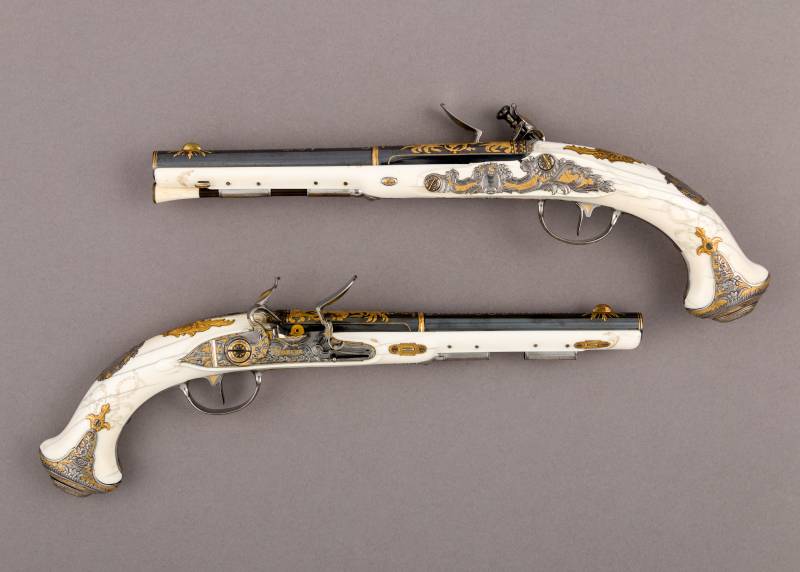
Flintlock pistols of Empress Catherine II, a gift to August Poniatowski. Metropolitan Museum of Art, New York
Blessed House of Petrov,
Elizabeth imitated
In the Monarch's height of gifts,
Freeing the oppressed
And encouraging the offended,
Tilted the height of heaven
Deliver you from evil fate,
To reign over us
And wipe away the currents of tears for us. "
A solemn ode to Her Imperial Majesty, the Most Blessed Most Sovereign Great Empress Empress Ekaterina Alekseevna, the Autocrat of All Russia, for Her glorious ascent to the All-Russian Imperial Throne on June 28, 1762. In an expression of true joy and loyal zeal, sincere congratulations are brought from the all-subject slave Mikhail Lomonosov.
History weapons. Well, what can you do, it was customary to cajole the rulers with gifts, whom God had granted for what: whoever wrote verses, he flattered with verses, who understood in handcrafts - did something material, beautiful and expensive. How many examples we know of when one European monarch in the Middle Ages gave another expensive armor, the eastern rulers bestowed sabers with ruby handles on each other, the rajahs in India (and the rajams!) Gave elephants, the gift of a valuable sword in Japan turned the enemy into a friend. And it is not surprising that this tradition continued in the days of firearms. And today we will tell you about some examples of such gift weapons. One can say about all these “products”: “the eye sees, but the tooth doesn’t care”, since even those that were made in Russia are very far from it today. But what to do, it just so happened. But we can at least look at them here ...
And since we sent poems about Catherine II as an epigraph, then ... let's start with the gifts of gunshot of her era. Perhaps the most interesting and luxurious gift was a pair of flintlock pistols by Catherine the Great (1729–1796), made in 1786 by the St. Petersburg gunsmith Johan Adolf Greke. They were part of a luxurious set of hunting weapons with ivory butts and stocks, made by him especially for the Empress. This was emphasized by the monogram "E" on the arm guards. The set originally consisted of a pair of pistols and a hunting rifle, and was made in 1786. And just Catherine gave it to her favorite, the last Polish king, Prince Stanislav August Poniatowski (1732-1798), whom she supported both as her lover and ... as the king of Poland (reigned 1763-1795). Interestingly, guns with an ivory stock in Western Europe had generally gone out of fashion by the 36,8th century, but in the last quarter of a century they were in vogue at the Russian court. The length of the pistols is 1986 cm. But where the gun is located is unknown. The pair entered the collection of the Metropolitan Museum of Art in New York as a gift in XNUMX.
The collection of the Metropolitan Museum also contains a pair of flintlock pistols for Grand Duke Konstantin Pavlovich (1779-1831). They were made around 1801. These pistols are part of a series of specially designed luxury firearms manufactured by the Tula Arms Factory to be presented to Emperor Alexander I and his three brothers on the occasion of his coronation in 1801. Each of the four siblings received a set of five elaborately decorated hunting rifles, including a smoothbore hunting rifle, a rifled carbine, blunderbuss, and a pair of pistols. This firearm is unique among Tula weapons for its neoclassical design, technical sophistication and intricate characteristic decorations. With this gift, the Tula plant not only paid tribute to its imperial patrons, but also demonstrated the technical experience and virtuoso skill for which it was so famous. No wonder the coat of arms of the Tula plant flaunts on each of these pistols.
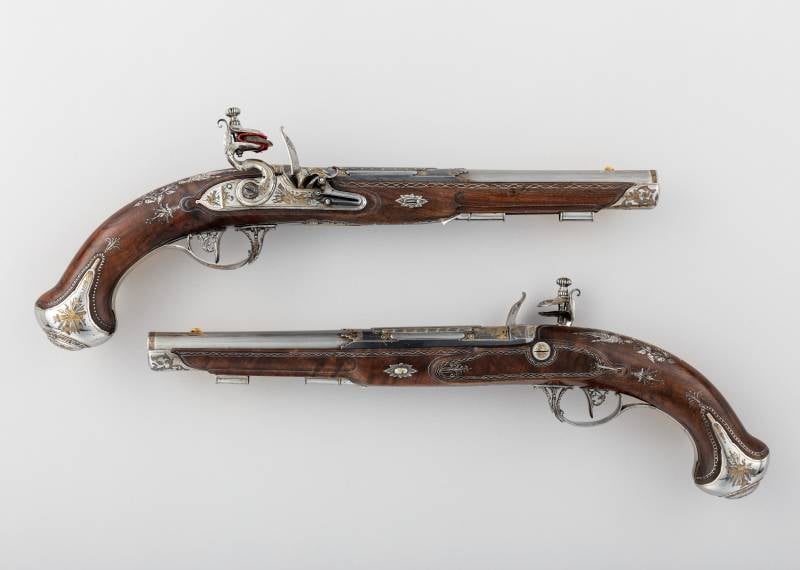
Pistols of Grand Duke Constantine. Tula Arms Factory (Russia, Tula, 1712 - present) approx. 1801 Materials: steel, silver, gold, wood. Dimensions: length 38,8 cm; barrel length 23,3 cm; caliber 15 mm; the weight of the pistols is different: one pistol - 821 g; second - 845 Metropolitan Museum of Art, New York
These pistols are very exquisitely designed. Their decoration, although abundant, is nevertheless more restrained than that of earlier Rococo samples. Blued or polished steel surfaces, accentuated by delicate gilded and inlaid silver ornaments, which is also typical for Tula products. The silver ornament in the box includes images of trophies and the imperial crown surrounding the owner's gold monogram. The precise processing of the trigger and trigger guard, which is very rare on Tula firearms, once again shows that the manufacture of pistols for the Grand Duke in Tula was taken very seriously. Well, how did they end up in this American museum? Gift - a gift to the museum made by a group of individuals in 2016. In the museum form, they are indicated in the same way as the donor of Catherine II's pistols.
However, many "gunshot gifts" came from overseas and to us. And they entered the Hermitage. But paired with them, and there was a tradition to make several identical gift copies, in order to choose the best one, were preserved at the place of manufacture. And it turned out to be very convenient. Because our museums must be asked for permission to publish their photographs, and this is not only computer, but also paperwork. But in the Metropolitan Museum everything is simple: this is a public domain photo (public property), and, therefore, you can use it. But this is not, and the photo simply does not have a download function. And why shouldn't our museums do this at home too?
Well, as for the "gunshot gifts", then the undisputed leader was none other than Samuel Colt. He gave cheap Colts to newspaper editors who wrote laudatory articles about him, more expensive revolvers to senators and generals, but the most luxurious specimens, sometimes at a cost of $ 400, went to foreign crowned heads to encourage them to order his revolvers in large quantities. Such was, for example, Colt's present gold-encrusted revolver "Marine Model 1851" (serial number 20133) with case and accessories, made around 1853.
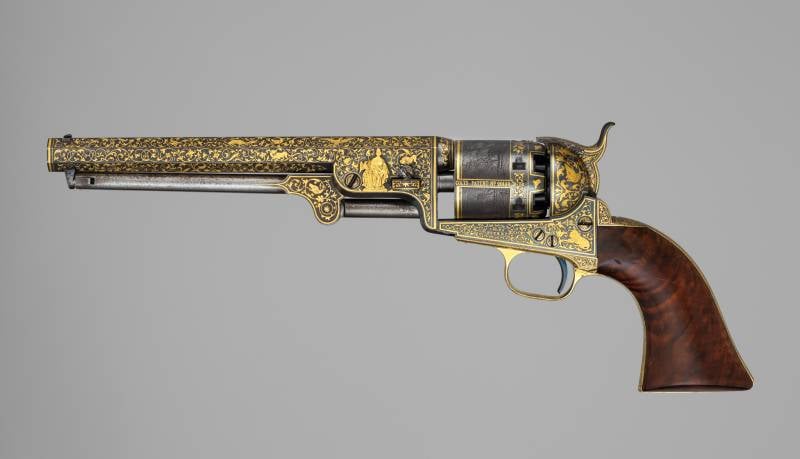
"Marine Model 1851". Material: steel, copper alloy, gold, wood (walnut), bone, tin. Dimensions: length 32,9 cm; barrel length 19,1 cm; caliber 9,14 mm; weight 1174, Metropolitan Museum of Art, New York
This revolver belongs to the rare Colt group of percussion firearms, decorated with abundant engraving, embossed carvings and gold inlaid flush or low relief, and there are only about twenty of them survived. Made at the direction of Samuel Colt (1814-1862) for exhibitions at international fairs and for donations to important officials, as well as heads of foreign and domestic states, including the kings of Sweden and Denmark, and the Tsar of Russia, they served as diplomatic gifts and at the same time demonstrated artistic and technical achievements of his company.
This revolver is one of two gold-encrusted Colts donated by the Robert M. Lee Foundation to the Met in honor of the museum's 150th anniversary. Revolvers are among the most significant additions to the museum's firearms collection in recent decades due to their great rarity, richness of their jewelry and historical significance.
Colt displayed his firearms to the public at international fairs, including the Great Exhibition of 1851 in London and the Exhibition of Industries of All Nations in New York in 1853. Moreover, over the course of his life, Colt, his company, and also his family distributed hundreds of revolvers for advertising purposes. But here's the interesting thing: this revolver does not have a dedication, while many of Colt's more modest presentation revolvers have the recipient's name inscribed on the back of the trigger guard.
Although the original purpose for this revolver has not been recorded, it is traditionally considered to be an addition to the gold-decorated naval revolver stored in the State Hermitage in St. Petersburg, that is, one of three gold-inlaid specimens donated by Samuel Colt to Tsar Nicholas I at the Gatchina Palace October 30, 1854. The serial number of the Metropolitan pistol (No. 20133), and the number for the Hermitage model (No. 20131), besides, both revolvers are decorated in the same style. So we can assume that they are both from the same "series".
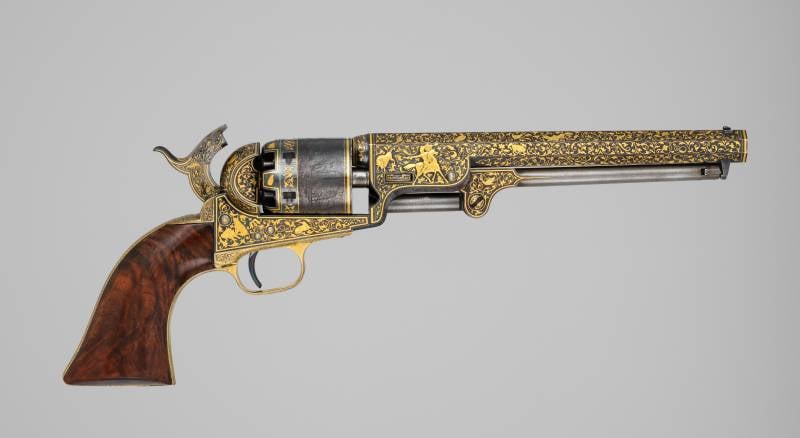
"Marine Model 1851". Right view. The frame depicts an Indian shooting a bison with a revolver. Metropolitan Museum of Art, New York
Two other gold-encrusted Colts donated to the Tsar and also kept in the Hermitage include the Dragoon Model III revolver (no. 12407) and the 1849 model pocket revolver (no. 63305). The partner of the Dragoon model is in the collection of the Metropolitan Museum (No. 12406).
The figured inserts of the Metropolitan revolver depict the goddess of freedom, a lion and a mounted Indian shooting a bison with a pistol. Many gold-encrusted Colts are also adorned with patriotic iconography, including the Museum Dragoon revolver, inlaid with the portrait of the first President of the United States, George Washington (1732–1799), and the coat of arms of the United States.
There is a clear European influence in inlay design, which is not surprising since many of the best firearms engravers who worked for Colt and other American arms manufacturers in the latter half of the 1850th century were German immigrants who came to the United States in the XNUMXs following a corresponding training in Germany.
Interestingly, the barrel of the Model 1851 revolver (also known as the "Belt Model") is hand engraved with a scene of the May 16, 1843 battle between the warships of the Texas Republic and Mexico. It was designed by Waterman Lilly Ormsby (1809–1883), a banknote engraver who worked for Colt since at least 1839. In addition to this naval scene, Ormsby designed the equally iconic cavalry battle and stagecoach robbery scene for Colt, which were then factory-engraved on the drums.
By the way, it should be noted that the model 1851 revolver, presented in the same year and produced until 1873, was one of the most popular and successful Colt shock revolvers. It had a .36 caliber, a seven and a half inches barrel and a six-shooter. He was light enough, accurate and reliable, many considered him an ideal personal weapon. It remained one of Colt's most popular models during the Civil War, even after the New Model Belt Revolver and the .1860 Army Colt were introduced in 44.
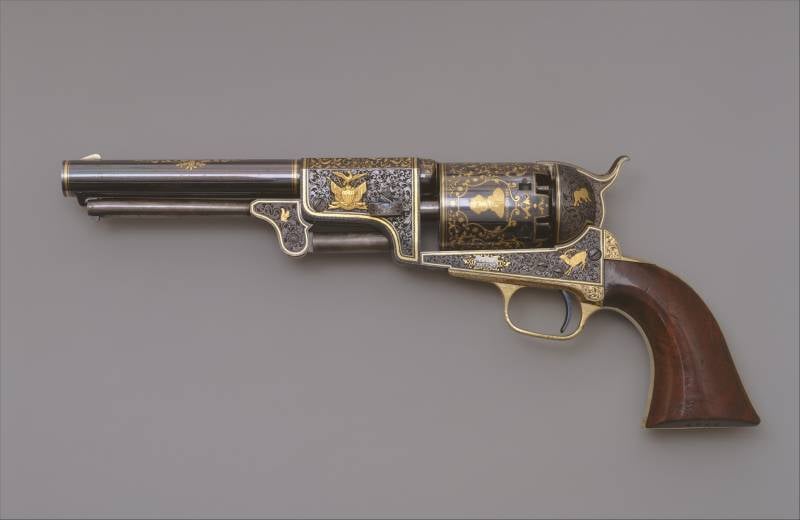
Colt Dragoon Model 3 (S / N 12406), c. 1853 Material: steel, brass, gold, wood (walnut). Dimensions: length 35,6 cm; barrel length 19,1 cm; caliber 11,2 mm; weight 1224, Metropolitan Museum of Art, New York
Colt's finest decorated revolvers, including this specimen, typically have deeply engraved blued steel surfaces with dense leafy curls with motifs such as human figures, animals, and birds, and invariably the Colt's name, inlaid with gold, flush with the surface. On the most luxurious examples, part of the inlay was done in relief, reminiscent of a sculpture in miniature.
This Dragoon revolver, like its “partner” (donated to Emperor Nicholas I), is considered one of the Colt's masterpieces, which he took with him to Europe in 1854. In the same year, the Crimean War broke out, in which Russia fought with Turkey and its allies, Great Britain and France, with Colt actively selling his weapons to both sides. In November 1854, he presented the Russian Tsar Nicholas I with three gold-encrusted revolvers, one from each pair. Of these, the third Dragoon is now in the collection of the Hermitage in St. Petersburg and has serial number 12407.
The gift clearly demonstrated the technical and artistic capabilities of the Colt firm, and the patriotic motives in the design once again emphasized its American origin. Indeed, one of the revolvers depicts a portrait of George Washington and the coat of arms of the United States, and a revolver made for the emperor - a view of the Capitol building in Washington.
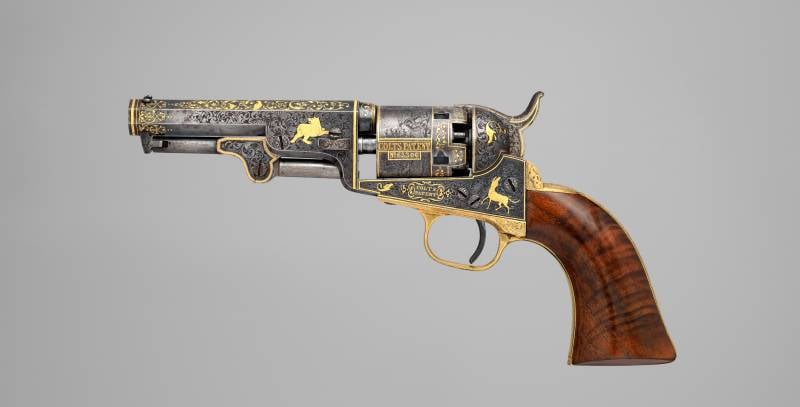
Pocket revolver Model 1849, inlaid with gold (serial number 63306), approx. 1853 Material: steel, copper alloy, gold, wood (walnut). Dimensions: length 22,1 cm; barrel length 10,2 cm; caliber 7,9 mm; weight 672 g. Metropolitan Museum of Art, New York
This pocket revolver from 1849 belongs to the rare group of Colt capsule revolvers, richly decorated with engraving, relief carving and gold inlay flush or low relief, of which, as we know, about twenty copies survived.
The serial number of this revolver (No. 63306) follows the number of another gold-decorated revolver (No. 63305) kept in the State Hermitage Museum in St. Petersburg. The Metropolitan Museum of Art Pocket Revolver is one of six famous model 1849 revolvers inlaid with gold. Each of them is decorated with engraved curls, and five pistols are also decorated with gold-encrusted animal figurines. As with other revolvers, the curls on the barrel and barrel are embossed rather than engraved. Therefore, we can say that they proudly rise above the background - a feature that, in addition to the gold trim of the revolvers, distinguishes them from hundreds of presentation weapons with small engravings produced by Colt for ... mass "offerings".
On the revolver we see the following engraved animals: fox, pheasant, leopard, bear, dog, eagle and wolverine. On the other hand, the cylinder is hand-engraved with the scene of the robbery of the stagecoach, which is found on the factory-made model 1849 pocket revolvers. True, most of the original blued surface has faded, traces of bluing are still visible, especially on the upper planes of the barrel near the muzzle and in the recesses of the cylinder.
The Model 1849 Pocket Revolver was produced until 1872 and was one of Colt's most popular weapons. It is believed that around 300 were produced. Its small size with four-, five- or six-inch barrels made it a very practical self-defense weapon. And the drum scene was essentially an instruction on how to deal with this kind of critical situation, or it suggested doing this kind of "business" yourself.
By the way, it is interesting that although Nicholas I and his family members received revolvers, Colt's efforts were wasted. There was no government order from the emperor to his firm. Its competitor, Smith & Wesson, which for many years became the monopoly manufacturer of revolvers for the Russian imperial army, managed to establish profitable cooperation with Russia, although later.
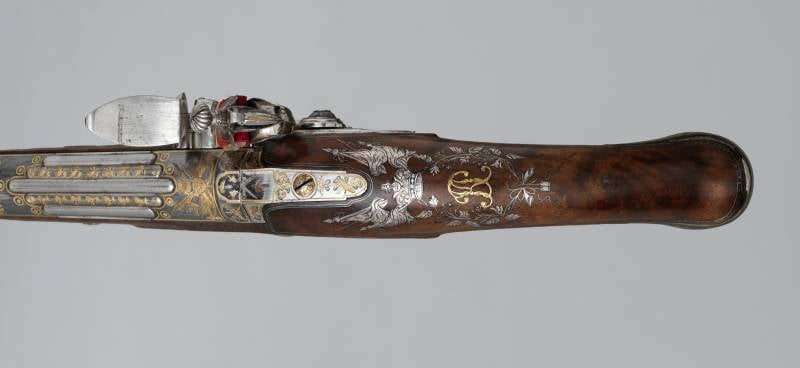
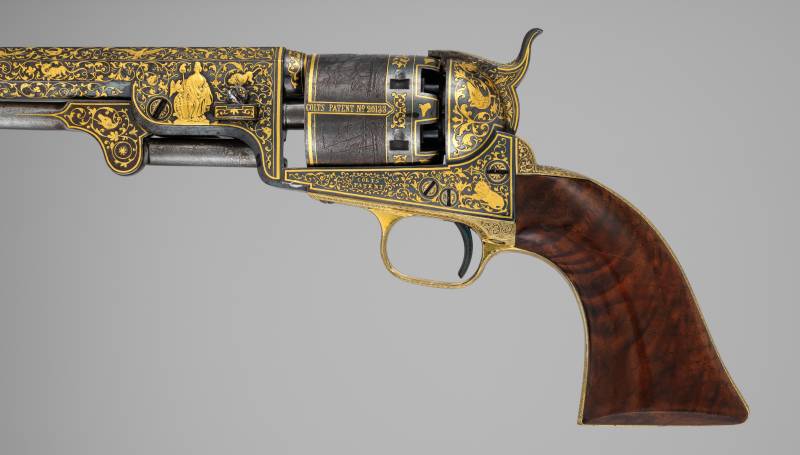
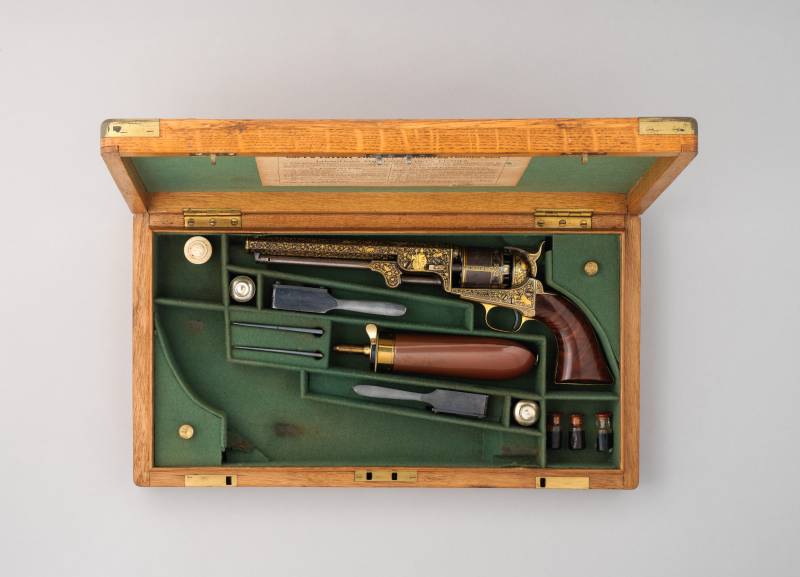
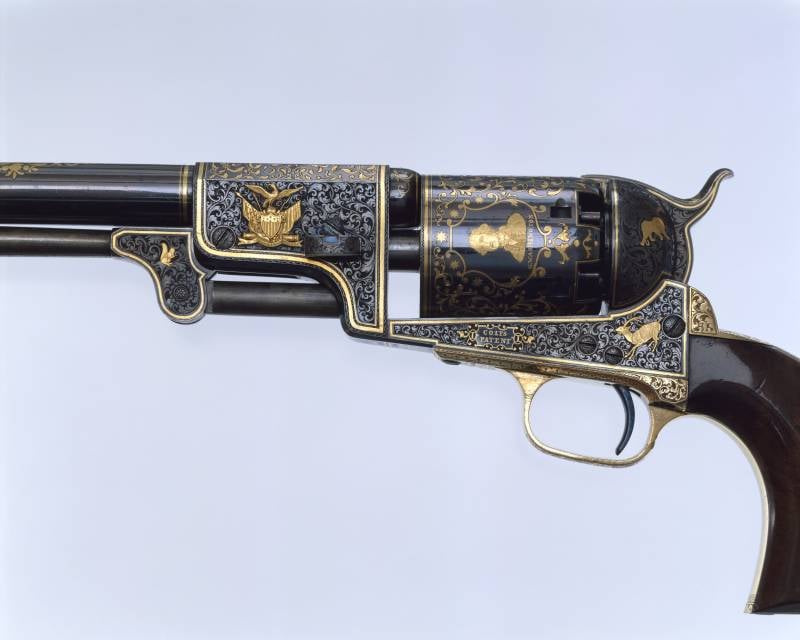
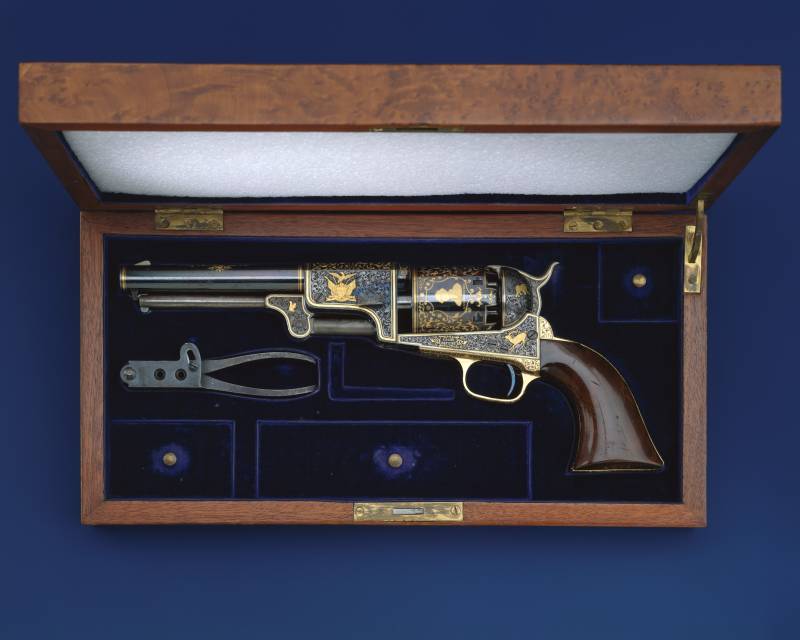
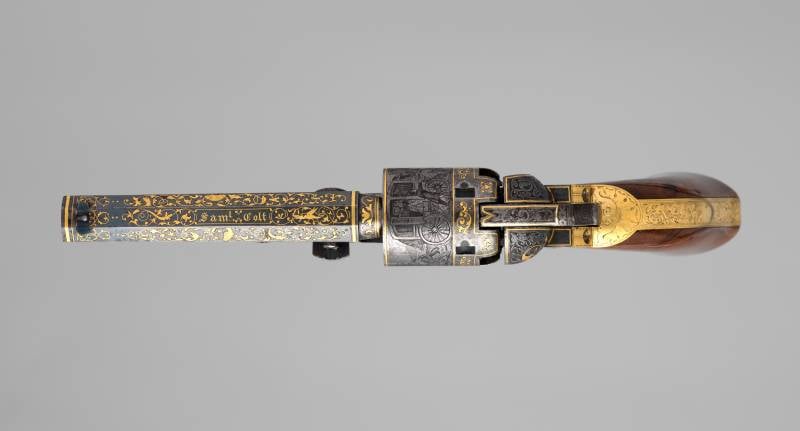
Information